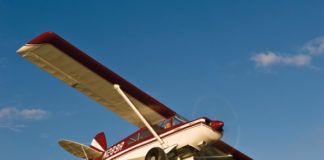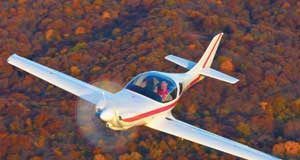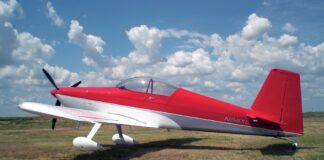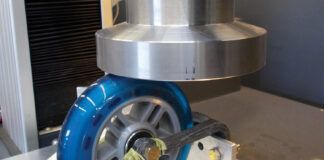Until Thursday, January 22, this years U.S. Sport Aviation Expo-the Light Sport Aircraft show at Sebring, Florida-was a question mark. Concern was obvious to everyone interested in sport aviation: In a severe recession, how will a small event that promotes light general aviation fare? Will people pay to attend a show that displays recreational products that may be increasingly out of reach?
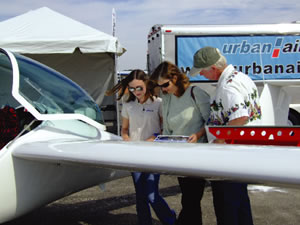
Checking out a Lambada motorglider. A family affair?
Exhibitors told me that by noon on opening day, they breathed a big sigh of relief because they saw a lot of people buying tickets to look at LSAs, said Bob Wood, event director for its five-year existence. At the end of four days, attendance was estimated at a record 11,500.
Great weather was a factor. Last years event was plagued by rain, cloudy and chilly conditions, and high wind. This years Expo began with sub-freezing temperatures under clear skies. But before noon on Thursday, we were peeling off layers, and each day dawned clear and warmer than the day before.
Another troublesome factor at Expo 08 was noise from races at the famous Sebring International Raceway, which adjoins the airport. Because of the racket, some exhibitors said they would not be back. In fact, this years Expo was postponed from its original date to avoid the race roar, and it worked.
Who Came?
Most of the major LSA airframes were present for the record public turnout. Cessnas SkyCatcher mockup was there. Following an unrecoverable-spin crash of a prototype last year-minus the test pilot who departed safely by parachute-Cessna has enlarged the tail and expects first deliveries of the more than 1000 orders late this year. American-built Piper lookalikes from Legend Cub and CubCrafters were shown and flown, along with a newly SLSA-approved RANS S-6 Coyote II plus the company’s S-7S Courier. SeaRey, which has made amateur-built kits for its amphibians for many years, showed its LSX two-seater, which is expected to be an approved SLSA soon. The LSX features many upgrades. For the first time, SeaMax demonstrated its sleek composite amphib in and out of the water at nearby lakes.
The number of companies displaying factory-built LSAs was down slightly from 2008s Expo, but the number of inside exhibitors increased.
A Different Breed
As noted in previous accounts of the Expo, Sebring is unlike other public aviation events. It is not billed as a fly-in, though those arriving by lightplane this year managed to fill Sebring Airports large apron. From the beginning, the show was designed to provide easy runway access for LSA company flybys and rides for prospective customers and for journalists.
As weather was not a concern, the green flag for the temporary LSA runway was up all day every day except during lunch when companies paraded their airborne wares around the pattern as the show announcer described what was being flown.
Most of the displayed aircraft were FAA-approved SLSAs, meaning they can be purchased ready to fly and may be flown by those with Sport Pilot or higher license classes. A few, including reps for the AMD CH-750 sheet metal high-wing and the composite SeaMax amphibian, claimed their SLSA approval was expected by the time you read this.
I flew six airplanes: an AMD CH-750 (which was covered in the February 09 KITPLANES), Paradise P-1, RANS S-6S, Legend Cub, amphibian SeaMax, and the Samba from Urban Air. Look for write-ups on the last five in future columns.
One closely watched aircraft, Randall Fishmans electric airplane, flew around the pattern for more than half an hour on its 18-horsepower electric motor and lithium batteries. Demonstrated by experienced glider pilot Joe Bennis, the single-seat Electra Flyer C used less than half its battery capacity, which costs about 50 cents worth of electricity per flight hour. Fishman hopes that his one-of-a-kind modified Monnett Moni motorglider will lead to a practical two-seat electric sportplane with a 50-hp brushless motor.
Keeping It Reasonable
Prices to attend and to exhibit at Expo have been kept low, Wood noted. Tickets were $12 per person plus $5 for parking each day. Outside exhibits were 40 feet square and included a 10×10-foot tent for $400. Inside 10×10-foot exhibit space complete with a table, two chairs, wireless Internet and electricity cost $300.
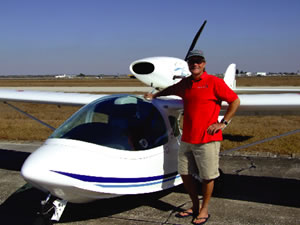
Malcolm Jones introduced the SeaMax splash-and-dash mode.
Companies ranging from Garmin, Rotax, Lockwood Aviation Supply, Avemco and Aircraft Spruce to local purveyors of airport property populated the five tents. Four nonprofit groups offered food that was good and somewhat underpriced compared with the usual aviation show fare. A big tent that accommodated large gatherings in the evenings doubled as the food court dining room.
The LSA Expo is organized as a profit-making Subchapter S corporation, but no one makes a salary, and the event relies on 250 volunteers. The objective, Wood said, is to have enough money to do it again next year.
Pattern Problems?
Wood acknowledged pilots concerns about the wide but short (300 by about 800 feet) LSA runway, which is the northwest end of Runway 14/32 before it intersects Runway 18/36. Traffic on 18/36 was controlled by a temporary tower, and LSA takeoffs on the no-radio-required short runway were run by hand signals. Landings on shortened Runway 32 required a two-part base leg to steer clear of Runway 36, and the 40 turn onto final for Runway 32 required being really low. To have the full 800 feet of runway available, some pilots were completing the final turn well below 50 feet. A southeast wind dictating takeoff the other direction-on shortened Runway 14-required an immediate 40 right turn to avoid crossing Runway 18/36.
I saw no close calls, and all aircraft with radios had the option of taxiing for takeoff and then landing on Runway 18/36. Some LSA pilots took advantage of this, but Wood said the Expo committee will look at other options for next year.
Each year the Expo committee invites a guest who speaks at the volunteers dinner and presents a forum. This year it was movie pilot Corkey Fornoff, whom I last saw in July 1975 when, as leader of the BD-5J demo team, he checked me out in the worlds smallest jet and chased me in another -5J on my first and only flight as PIC of a turbojet. He now demonstrates something probably as much fun and certainly more powerful-one of the three LoPresti Fury prototypes. Originally based on the hot little post-WW-II Swift, the Fury is said to go 200 knots on 10 gph and has built-in toys including forward-looking television for taxiing, electronically adjusted canopy tint, and a laser tag transmitter and receiver for simulated air combat. Load- and flight-testing are planned for the other two Furys. When certified and in production, they are intended to cost $380,000. Unfortunately, this side-by-side, two-seat taildragger doesn’t meet other LSA definitions.
Wrapping Up
Dan Johnson, president of LAMA, estimated that about 20 aircraft were sold at the Expo for a total of close to $2.5 million. Before the official opening on the last day, British aviation photographer Steven Fletcher was killed and pilot Michael Kostelac was seriously injured as they took off in a Remos for a photo mission. The airplane began to bank as it became airborne and crashed inverted alongside the runway.
The tragedy marred an otherwise flawless Sebring LSA Expo. Representatives from other venues-Sun n Fun and AirVenture Oshkosh, for example-left feeling better about their prospects in this years economy.
For more information and dates for next years event, visit www.sport-aviation-expo.com. The hope is to once again avoid big Sebring Raceway competition.
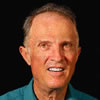
![]()
Dave Martin served as editor of this magazine for 17 years and began aviation journalism evaluating ultralights in the early 80s. A former CFI (airplanes, gliders, instruments), hes flown more than 160 aircraft types plus 60 ultralights (including a single-seat, no-basket hot air balloon). Now living at a residential airpark in Oregon, he flies his Spacewalker II homebuilt as a Sport Pilot.

